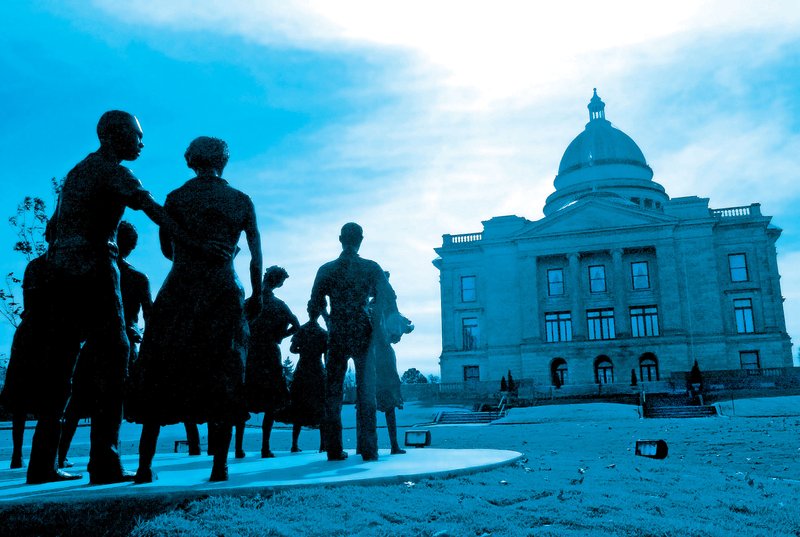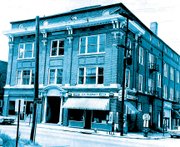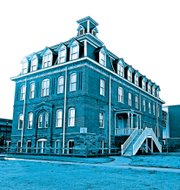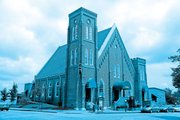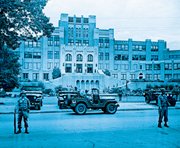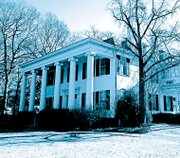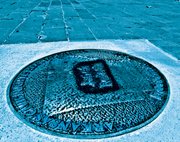They are spots we drive or walk by every day. Most are innocuous, familiar landmarks that make up a city — churches, schools, street corners, neighborhoods.
All are a part of the history of civil rights in Little Rock and can be found on the Arkansas Civil Rights History Tour app, which debuted in 2015. There are 36 stops on the app, with narration in English or Spanish, and which was funded by a grant from the Arkansas Humanities Council. The app was also a collaboration of the University of Arkansas at Little Rock’s Institute on Race and Ethnicity, Little Rock, the Mayor’s Tourism Commission and public radio station KUAR.
Several of the spots, including the Little Rock Nine Memorial and Little Rock Central High School, are now on the newly announced United States Civil Rights Trail.
So, let’s take a spin around some of the stops on the tour using information found on the handy app, which is available in the Apple App Store, the Google Play store or at littlerock.com.
• Historic West Ninth Street
BROADWAY AND WEST NINTH
The thriving corridor of black social life and businesses that served the Little Rock black community from the 1880s through the 1950s.
• The Lynching of John Carter
WEST NINTH AND BROADWAY
The spot where, on May 4, 1927, the body of John Carter, a 38-year-old black man who was lynched by a mob for allegedly assaulting two white women, was dragged and burned while thousands of white onlookers gathered.
• Mosaic Templars of America
501 W. NINTH ST.
Formed in 1882 by Arkansas freedmen John Edward Bush and Chester W. Keatts to provide insurance and other services to black people, the Mosaic Templars of America was incorporated as a fraternal organization and, by the 1920s, had an estimated membership of 100,000. The Templars Headquarters Building and annex and State Temple buildings on Broadway anchored the Historic West Ninth Street business district.
• Mosaic Templars Cultural Center
501 W. NINTH ST.
Opened in 2008 on the site of the original Templars Headquarters Building, which burned in 2005, the Mosaic Templars Cultural Center “collects, preserves, interprets and celebrates the state’s African American political, economic and social achievement from 1865 to 1950” and is the first publicly funded museum of black history and culture in Arkansas.
• Taborian Hall and Dreamland Ballroom
800 W. NINTH ST.
Built between 1916-1918 and now on the National Register of Historic Places, Taborian Hall is one of the last reminders of the West Ninth street business district. The building was home to the Knights and Daughters of Tabor, a fraternal insurance organization. Black soldiers from Camp Pike came to the Negro Soldiers Service Center there during World War I. It was home to the Ninth Street USO during World War II. It now houses Arkansas Flag and Banner.
Dreamland Ballroom on the third floor was a regular stop for popular black performers. Cab Calloway, Count Basie, Duke Ellington, Ella Fitzgerald, Redd Foxx and many others performed there.
• First Missionary Baptist Church
701 S. GAINES ST.
Established in 1845, First Missionary Baptist Church is one of the oldest black congregations in Arkansas. The current church was built in 1882 and is on the National Register of Historic Places. In 1891, More than 600 black people protested here in response to the state’s Separate Coach Law, which required racial separation in passenger cars and separate waiting rooms in train stations. Dr. Martin Luther King Jr. visited the church twice.
• Philander Smith College Historic District
900 W. DAISY GATSON BATES DRIVE.
Wesley Chapel
1109 STATE ST.
The oldest historically black college in Little Rock, Philander Smith College was established in 1877 as Walden Seminary by the A̶f̶r̶i̶c̶a̶n̶ ̶M̶e̶t̶h̶o̶d̶i̶s̶t̶ ̶E̶p̶i̶s̶c̶o̶p̶a̶l̶ ̶C̶h̶u̶r̶c̶h̶ United Methodist Church* to educate ministers. Its name was changed in 1882 after an endowment by the widow of Illinois philanthropist Philander Smith.
Wesley Chapel was founded by the enslaved William Wallace Andrews on land donated by his owner, U.S. Senator Chester Ashley. The chapel has long been associated with the college.
• Mt. Zion Baptist Church
908 S. STATE ST.
Organized in 1877, Mt. Zion is one of the earliest black congregations in Little Rock. It was rebuilt in its present location in 1927 under the leadership of the Rev. Fred T. Guy, who challenged the Little Rock School Board to desegregate schools in 1957.
• Arkansas Baptist College
1621 MARTIN LUTHER KING, JR., DRIVE.
In 1884, the Rev. E.C. Morris and the National Baptist Convention established Arkansas Baptist College to train black students for the ministry and to become teachers. The college settled into its current location in 1885. In 1887, former slave the Rev. Joseph A. Booker was appointed president and served for nearly 40 years. In 2006, the college started the African American Leadership Institute and, in 2015, the Scott Ford Center for Entrepreneurship and Community Development.
• Central High School Neighborhood Historic District
1500 S. PARK ST.
An interracial, middle-class, mixed-use area, the Central High School Neighborhood Historic District was first developed in the late 1880s after a streetcar company built West End Park there. The park became home to the city’s minor league baseball team, The Arkansas Travelers, in 1894. Several Negro League teams also played there. In the late 1920s, the park was chosen as the site for the whites-only Little Rock High School.
• Central High School
1500 S. PARK ST.
In September, 1957, Little Rock’s Central High School became a symbol for the struggle over school desegregation. On the night before the school was to be integrated by nine black students, Gov. Orval Faubus ordered National Guard soldiers to surround the school and the students were denied entry. Faubus eventually removed the soldiers, but the students — Ernest Green, Minnijean Brown, Elizabeth Eckford, Thelma Mothershed, Melba Patillo, Gloria Ray, Terrence Roberts, Jefferson Thomas and Carlotta Walls — were met by an angry mob and had to be removed for their safety. President Dwight D. Eisenhower sent federal troops to protect the students, who nevertheless suffered numerous attacks while attending the school. On May 27, 1958, Ernest Green, the only senior among the Little Rock Nine, became the first black student to graduate from Central.
• Central High School National Historic Site and Visitors Center
VISITOR CENTER:
2120 W. DAISY
BATES DRIVE.
SCHOOL: 1500 S. PARK ST.
Opened in 2007 to mark the 50th anniversary of the school’s desegregation, the Central High School National Historic Site and Visitors Center includes historic clips, interactive displays and interviews with the Little Rock Nine. Central High School is the only functioning high school in the United States that is located within a national historic site.
• Daisy Bates House Museum
1207 W. 28TH ST.
Home of Luscious Christopher “L.C.” and Daisy Bates, civil rights activists and co-owners of the Arkansas State Press newspaper. The home was the headquarters and haven for the Little Rock Nine during the 1957 desegregation crisis. Daisy Bates, a mentor to the Nine, was president of the Arkansas State Conference for the National Association for the Advancement of Colored People (NAACP).
• Paul Laurence Dunbar High School
1100 WRIGHT AVE.
Completed in 1929 and modeled on Little Rock High School (which became Little Rock Central), the school attracted black students from all over Arkansas in part because it featured college preparatory classes along with the vocational-industrial studies offered in black schools at the time.
• Sue Cowan Williams Library
1800 S. CHESTER ST.
Williams, chair of the English department at Dunbar High School, successfully sued the Little Rock School District in 1945 for equal pay for black teachers and white teachers. During her suit, her contract at Dunbar was not renewed. She was rehired at the school in 1952 and remained there until her 1974 retirement. She died in Little Rock in 1994. The 10th library in the Central Arkansas Library System was dedicated in her honor in 1997.
• MacArthur Park
503 E. NINTH ST.
Little Rock’s first city park, the Quapaw Line Marker here denotes the western survey line of land that the Quapaw Indians were allowed to retain after ceding ancestral lands to the United States in 1818. The Indian Removal Act of 1830 forced southeastern tribes to move to what is now Oklahoma, with several routes crossing Arkansas.
• Pike-Fletcher-Terry House
411 E. SEVENTH ST.
The antebellum house where, in 1958, 76-year-old Adolphine Fletcher Terry organized the Women’s Emergency Committee to Open Our Schools after the 1957 desegregation crisis.
• Concordia Hall
409 PRESIDENT CLINTON AVE.
As immigration grew after the Civil War, the first Jewish congregation in Little Rock was chartered in 1866 as B’Nai Israel. During the 1880s, the Concordia Association, a Jewish social club, was located above the Porbeck and Bowman Building. The site is now a part of CALS’ Institute for Arkansas Studies.
• Historic Arkansas Museum
200 E. THIRD ST.
A permanent museum exhibit, “We Walk in Two Worlds,” tells the story of the Caddo, Osage and Quapaw tribes who first lived in Arkansas.
• Old State House Museum
300 W. MARKHAM ST.
The oldest standing state capitol west of the Mississippi, the Old State House was a center of political activity. Eight black men were delegates to the 1868 Constitutional Convention held there. By 1874, 20 black men were serving in the General Assembly.
• Testament, Civil Rights Memorial Sculpture of the Little Rock Nine
NORTH LAWN OF CAPITOL GROUNDS
ONE CAPITOL AVE. AT WOODLANE STREET
Sculpture from 2005 by Arkansas Democrat-Gazette editorial cartoonist John Deering; his wife, Kathy, and studio partner, Steve Scallion, depicting the Little Rock Nine.
• The Trail of Tears, the Quapaw
Line and American Indians in Arkansas
TRAIL OF TEARS PARK,
5700 ASHER AVE.
The Quapaw Line marks the boundary between land designated for white settlers and the Quapaw Indians. At the University of Arkansas at Little Rock, the Trail of Tears Park commemorates routes used by tribes leaving their ancestral homes after the Indian Removal Act of 1830. The Sequoyah National Research Center at UALR holds the largest collection of American Indian written words and art in the world.
• The Bracero Program and Latina/o Arkansans
MEXICAN CONSULATE, 3500 S. UNIVERSITY AVE.
Thousands of Mexican workers were brought to the Arkansas Delta from 1942 through 1964 with the Bracero Program. Braceroes, Spanish for manual laborer, fought back against discrimination and economic exploitation and helped establish the first minimum wage for farm workers in the Delta. Little Rock is one of a small number of U.S. cities with a Mexican Consulate.
• Arkansas Civil Rights Heritage Trail
VARIOUS LOCATIONS ALONG MARKHAM STREET AND PRESIDENT CLINTON AVENUE
The trail was started in 2011 by the UALR Institute on Race and Ethnicity. A theme is chosen each year to honor those active in Arkansas’ civil rights movement.
• Freedom Riders and Sit-in Demonstrators
PLAQUE AT 201 W. MARKHAM ST.
MARKERS AT 300 W. MARKHAM ST.
Freedom riders spread across the South in 1961 to pressure communities and the government to implement court-ordered desegregation of bus terminal facilities. Little Rock’s first Freedom Riders arrived on July 10 at the Mid-West Trailways bus station at Markham and Louisiana. Five markers also commemorate Philander Smith College students involved in sit-in demonstrations between 1960 and 1962 along with members of the Arkansas Student Non-Violent Coordinating Committee.
*CORRECTION: Philander Smith College in Little Rock was founded by the United Methodist Church. Information from a civil rights history app in a previous version of this story was incorrect.

